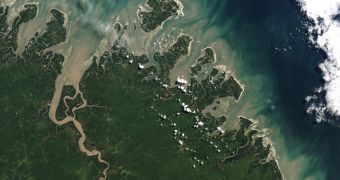Using satellite imagery, experts at the American space agency were recently able to identify a large number of new barrier islands. These landmasses are located near the coast of all continents except Antarctica, and are sustainable ecosystems onto themselves.
There are many types and shapes of barrier islands. Some of them are only sandbars emerging a few feet above water level, while others are large, and even contain vegetation. But all of them play important roles in their region.
As their names suggest, these islands are responsible for calming ocean waters – as well as some storms – as they make their way towards dry land. Due to the fact that they run parallel to the coastlines, they can be used as outpost and research stations too.
They face the sea head-on, and are oftentimes severely eroded by frantic waves. These islands also bear the brunt of intense winds and other atmospheric events. At the same time, due to their influence, landscape feature beyond them remain untouched.
Precious lagoons, bays and gulfs can retain their pristine condition thanks to the barrier islands, which do not allow nature to unleash its full fury on the shorelines. Interestingly, these barriers are mobile, constantly shifting position and orientation in response to external factors.
Currents, tides, winds, and human activity are the primary elements that shape up these islands. Regardless, not all of them have been detected thus far. Even nowadays, scientists conducting satellite surveys of shorelines continue to identify new barrier islands.
In a brand-new survey aimed at doing exactly that, experts in the United States were able to find 657 new barrier islands. The work was led by Merredith College expert Matthew Stutz and Duke University investigator Orrin Pilkey.
“It's not that 657 islands appeared overnight. We simply did a more thorough job of counting what was already out there,” Stutz explains. A 2001 survey only found 1,492 barrier islands worldwide, whereas the new one found 2,149.
Interestingly, these islands may increase in number over the coming years, as global warming grabs a hold of the world. Though counter-intuitive, sea level rise may actually promote the appearance of new barrier islands, especially where rivers flow into oceans or seas.
“It would be nice if we could say we can predict exactly how a given island or island chain will react to rising sea levels or some other environmental change, but we're simply not there yet for most islands, especially for many tropical islands where research dollars are scarce,” Stutz explains.
“We're still a long way from being able to accurately model how an individual island will change as a result of climate change or even simple development pressure,” the expert concludes, quoted by NASA.

 14 DAY TRIAL //
14 DAY TRIAL //